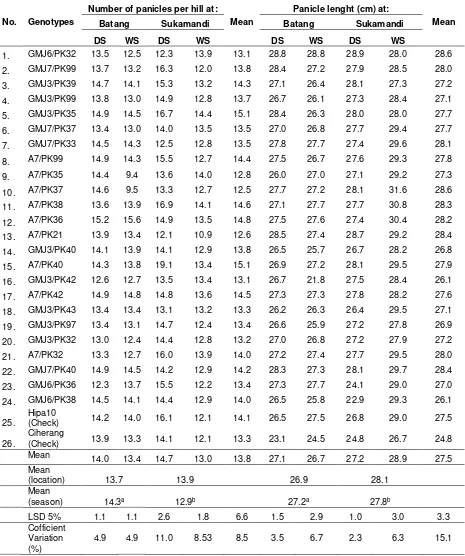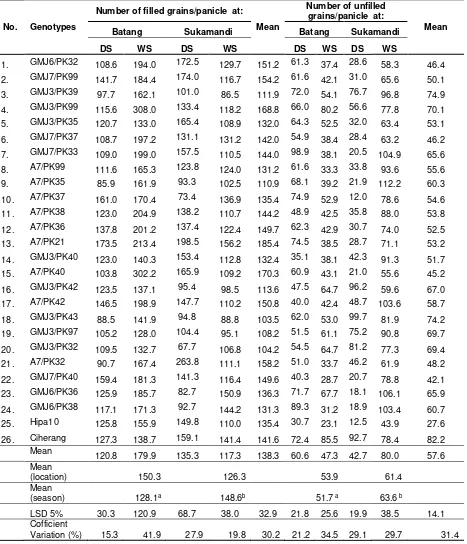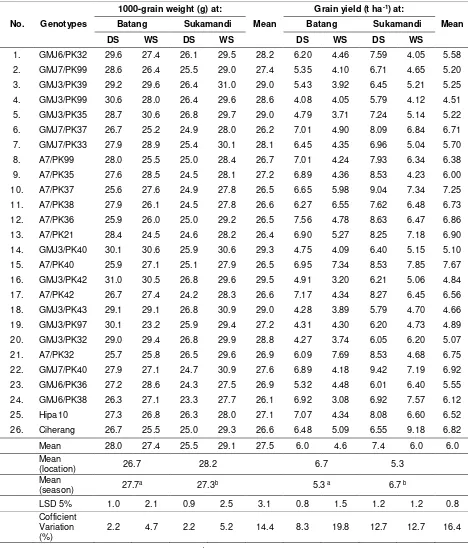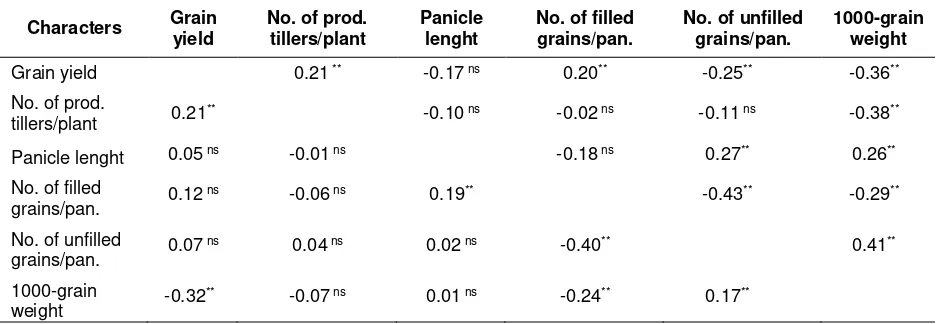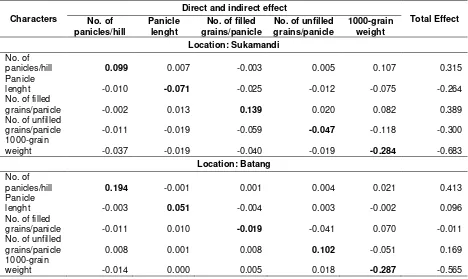PERFORMANCE OF PROMISING HYBRID RICE IN TWO DIFFERENT ELEVATIONS
OF IRRIGATED LOWLAND IN INDONESIA
Yuni Widyastuti*), Satoto and I.A. Rumanti
Indonesian Center for Rice Research
Jl. Raya 9 Sukamandi Subang 41256 West Java Indonesia
*) Corresponding author E-mail: [email protected]
Received: April 19, 2015 /Accepted: May 15, 2015
ABSTRACT
The hybrid rice program has been established
since early 1990’s at the Indonesia Center for Rice Research (ICRR). Twenty-four experimental hybrid rice varieties which have been developed were tested in lowland rice fields in Sukamandi (West Java) and Batang (Central Java) during the dry season and the rainy season of 2012. Randomized complete block design (RCBD) with three replications was used in each location. The results showed that grains yields were affected by locations, seasons, and genotypes. The genotypes x locations x seasons interaction effect was significant; therefore, the best hybrid was different for each location and season. A7/PK36 hybrid has the best performance in Batang during the dry season, while A7/PK40 and A7/PK32 are the best hybrids in the rainy season. In Sukamandi, nine hybrids were identified as better yielder than that of the check cultivar in the dry season, but not so in the rainy season. Using the correlation and path analysis, we found that the number of panicles per hill and the number of filled grains per panicle could be used as selection criteria for yield in hybrid rice.
Keywords: agronomic performance, correlation, hybrid rice, lowland
INTRODUCTION
Rice is an important crop in Indonesia due
to its significance as the country’s first staple
food. To increase rice production, there is a slim probability for further expansion in rice area; technology has been applied succesfully in China since 1976 (Kueneman, 2006). Indonesia has been active in developing hybrid rice as an alternative strategy to improve rice productivity.
Research on hybrid rice in Indonesia began in 1983 with the aim of exploring prospects and constraints of this technology. Since 1998 the research has been further intensified to breed suitable parental lines and F1 hybrid from the local germplasm. Up to 2011,
Indonesian Center for Rice Research had released 17 hybrid rice varieties with some yield advantage over inbreed varieties, Ciherang and IR64 as popular varieties. However, hybrid rice which has been released is susceptible to pests and diseases, and the heterotic effect was not stable. Breeding programs to improve the resistance of parental lines and the F1 hybrid
have been intensified (Satoto et al., 2013). Parental lines of the hybrids developed in Indonesia are mostly derived from introduced lines, which are more susceptible to stresses as well as pests and diseases. Therefore, it is imperative to develop a hybrid variety using Indonesian parental line, which is well adapted to the local environment by identifiying elit lines as restorer and maintainer (Nugraha et al., identified as having good resistance to BLB.
High grain yield of rice has been the primary objective in the breeding programs. The character is complex and controlled by a number of interactive, duplicative, and/or epistatic genes, and is affected by environment (Reddy et al., 1986). High yielding character of hybrid rice is
Accredited SK No.: 81/DIKTI/Kep/2011
also determined by the level of heterosis expressed by the hybrid. Chen et al. (2007) stated that the super hybrid rice should have the following criteria: good rice quality, wide adaptation, lodging resistance, resistant to main insects and diseases, and the yield exceeds 8% over control varieties in the national trials.
Grain yield is a complex polygenic quantitative trait, greatly affected by the environment. Hence, selection of superior genotypes based on yield may not be effective. Information on the correlation between yield and its components is important to make formulation for selection criteria of yield. Board et al. (1997) suggest that the yield components which can be used for the selection criteria are: (i) yield components which have positive correlation and high direct effect on grain yield, (ii) it has large direct effect although less correlated with grain yield, and (iii) characters which have negative indirect effect on grain yield through other characters. The research objectives are to evaluate the grain yield and its components of some promising hybrid rice in lowland rice fields and to analyze the relationship between yield and its components.
MATERIALS AND METHODS
Twenty-four new promising hybrid rice are used as testing materials, compared to Hipa10 as hybrid check variety and Ciherang as popular inbred check variety. These hybrids are derived from one CMS introduction (A7), three CMS improved resistant to pest and desease (GMJ3, GMJ6, and GMJ7), and 13 restorer lines from ICRR. Field experiments were conducted during the 2012 dry season (DS) and rainy season (WS) at two locations i.e. Sukamandi, West Java (Alluvial, 16 m above sea level ) and Batang, Central Java (Latosol, 276 m above sea level), Indonesia. Experiments were laid out in a randomized complete block design (RCBD) involving 26 genotypes with three replications. The plot size was 2 x 5 m2.
The land for the experiments was plowed and harrowed. Fertilizer of 300 kilos of urea/ha, 100 kilos of TSP/ha, and 100 kilos of KCl/ha were applied following the recommended time and doses. Twenty-one day old seedlings were was done when weeds were observed. Standard cultural practices were followed. The crop was protected from insect pest and diseases using chemical control as needed. Harvesting was done manually when 85% of the grains in the upper portion of the panicle were yellow and those at the base are at hard dough stage. Each plot was harvested after cutting one border of determine treatment differences using the procedure as described by Gomez (1985). Hybrid yield performance was compared with check varieties based on least significant difference (LSD) value at the 5%. Partitioning the correlation coefficient of characters into direct and indirect effects was carried out using the procedure described by Singh and Chaudary (1979).
RESULTS AND DISCUSSION
component in rice. The hybrid with low tillering capacity is not required in transplanted rice culture.
Generally, larger panicle is associated with high number of grains/panicle resulting in higher productivity. The five hybrids having panicle significantly longer than Ciherang (24.8 cm) were GMJ6/PK32, A7/PK38, A7/PK36, A7/PK21, and GMJ7/PK40. The number of grains/panicle consists of number of filled and unfilled grains/panicle. There were three hybrids resulted significantly in more number of filled grains/panicle than Hipa10 (135); while hybrid A7/PK21 produced significantly more number of filled grains/panicle than Hipa10 and Ciherang (142). Another hybrid produced equal or less number of filled grains per panicle than both of check varieties (Table 3).
The 1000-grain weight in the hybrids ranged from 22.8-29.5 grams (Table 4). None of the hybrids showed significantly higher or lower than Hipa10 (27.1 g) and Ciherang (26.6 g). Hybrids A7/PK37 and GMJ6/PK38 produced the minimum 1000-grain weight (22.8 g). Hybrid GMJ3/PK42 produced the highest (29.5 g) 1000-grain weight. Eight hybrids look more like Ciherang, the most popular rice inbred in the farmers, namely A7/PK99, A7/PK37, A7/PK38, A7/PK36, A7/PK21, A7/PK40, A7/PK42 and A7/PK32. Similarly, 1000-grain weight is also an important component that contributes towards the increase in yield. In Indonesia, farmers will be more interested in developing hybrid varieties if they have the same shape and size as Ciherang.
Performance of Grain Yield
In average, the grain yield of the hybrid rice was higher in dry season compared to rainy season, while the grain in Sukamandi was also higher than in Batang. In Sukamandi, there were nine hybrid rice which gave higher yield A7/PK32) were better than Ciherang in the rainy season. season. The hybrids showing better performance in the dry season were GMJ7/PK37, A7/PK35, A7/PK37, A7/PK36, A7/PK21, A7/PK40, A7/PK42 and GMJ7/PK40 (Table 3). Standard heterosis is defined as the amount by which a hybrid exceeds the most popular variety. The hybrids gave standard heterosis from 16.1% (GMJ7/PK37) to 25.4% (GMJ7/PK40). None of the hybrids showed better performance than Ciherang in the rainy season except A7/PK40. This hybrid gave grain yield 7% higher over Ciherang.
Table 2. Number of panicle per hill and panicle lenght of 26 hybrids rice grown in two location and two season, 2012
No. Genotypes
Number of panicles per hill at:
Mean
Panicle lenght (cm) at:
Mean Batang Sukamandi Batang Sukamandi
DS WS DS WS DS WS DS WS
1. GMJ6/PK32 13.5 12.5 12.3 13.9 13.1 28.8 28.8 28.9 28.0 28.6
2. GMJ7/PK99 13.7 13.2 16.3 12.0 13.8 28.4 27.2 27.9 28.5 28.0
3. GMJ3/PK39 14.7 14.1 15.3 13.2 14.3 27.1 26.4 28.1 27.3 27.2
4. GMJ3/PK99 13.8 13.0 14.9 12.8 13.7 26.7 26.1 27.3 28.4 27.1
5. GMJ3/PK35 14.9 14.5 16.7 14.4 15.1 28.4 26.3 28.0 28.0 27.7
6. GMJ7/PK37 13.4 13.0 14.0 13.5 13.5 27.0 26.8 27.7 29.4 27.7
7. GMJ7/PK33 14.5 14.3 12.5 12.8 13.5 27.8 27.7 27.4 29.6 28.1
8. A7/PK99 14.9 14.3 15.5 12.7 14.4 27.5 26.7 27.6 29.3 27.8
9. A7/PK35 14.4 9.4 13.6 14.0 12.8 26.0 27.0 27.1 29.2 27.3
10. A7/PK37 14.6 9.5 13.3 12.7 12.5 27.7 27.2 28.1 31.6 28.6
11. A7/PK38 13.6 13.9 16.9 14.1 14.6 27.1 27.7 27.7 30.8 28.3
12. A7/PK36 15.2 15.6 14.9 13.5 14.8 27.5 27.6 27.4 30.4 28.2
13. A7/PK21 13.9 13.4 12.1 10.9 12.6 28.5 27.4 28.7 29.2 28.4
14. GMJ3/PK40 14.1 13.9 14.1 12.9 13.8 26.5 25.7 26.7 28.2 26.8
15. A7/PK40 14.3 13.8 19.1 13.4 15.1 26.9 27.2 28.1 29.5 27.9
16. GMJ3/PK42 12.6 12.7 13.5 13.4 13.1 26.7 21.8 27.5 28.4 26.1
17. A7/PK42 14.9 14.8 14.8 13.6 14.5 27.3 27.3 27.8 28.2 27.6
18. GMJ3/PK43 13.4 13.4 13.1 13.2 13.3 26.2 26.3 26.4 29.5 27.1
19. GMJ3/PK97 13.4 13.1 14.7 12.4 13.4 26.6 25.9 27.2 27.8 26.9
20. GMJ3/PK32 13.0 12.4 14.4 12.8 13.2 27.0 26.8 27.2 27.9 27.2
21. A7/PK32 13.3 12.7 16.0 13.9 14.0 27.2 27.4 27.7 29.5 28.0
22. GMJ7/PK40 14.9 14.5 14.2 12.9 14.2 28.3 27.3 28.1 29.7 28.4
23. GMJ6/PK36 12.3 13.7 15.5 12.2 13.4 27.3 27.7 24.1 29.0 27.0
24. GMJ6/PK38 14.5 14.1 14.4 12.9 14.0 26.5 25.8 22.9 29.3 26.1
25.
Hipa10
(Check) 14.2 14.0 16.1 12.1 14.1 26.5 27.5 26.8 29.0 27.5
26.
Ciherang
(Check) 13.9 13.3 14.1 12.1 13.3 23.1 24.5 24.8 26.7 24.8 Mean 14.0 13.4 14.7 13.0 13.8 27.1 26.7 27.2 28.9 27.5
Mean
(location) 13.7 13.9 26.9 28.1
Mean
(season) 14.3a 12.9b 27.2a 27.8b
LSD 5% 1.1 1.1 2.6 1.8 6.6 1.5 2.9 1.0 3.0 3.3
Cofficient Variation (%)
4.9 4.9 11.0 8.53 8.5 3.5 6.7 2.3 6.3 15.1
Table 3. Number of filled and unfilled grains per panicle of 26 hybrids rice grown in two location and two season, 2012
No. Genotypes
Number of filled grains/panicle at:
Mean
Number of unfilled grains/panicle at:
Mean Batang Sukamandi Batang Sukamandi
DS WS DS WS DS WS DS WS
1. GMJ6/PK32 108.6 194.0 172.5 129.7 151.2 61.3 37.4 28.6 58.3 46.4
2. GMJ7/PK99 141.7 184.4 174.0 116.7 154.2 61.6 42.1 31.0 65.6 50.1
3. GMJ3/PK39 97.7 162.1 101.0 86.5 111.9 72.0 54.1 76.7 96.8 74.9
4. GMJ3/PK99 115.6 308.0 133.4 118.2 168.8 66.0 80.2 56.6 77.8 70.1
5. GMJ3/PK35 120.7 133.0 165.4 108.9 132.0 64.3 52.5 32.0 63.4 53.1
6. GMJ7/PK37 108.7 197.2 131.1 131.2 142.0 54.9 38.4 28.4 63.2 46.2
7. GMJ7/PK33 109.0 199.0 157.5 110.5 144.0 98.9 38.1 20.5 104.9 65.6
8. A7/PK99 111.6 165.3 123.8 124.0 131.2 61.6 33.3 33.8 93.6 55.6
9. A7/PK35 85.9 161.9 93.3 102.5 110.9 68.1 39.2 21.9 112.2 60.3
10. A7/PK37 161.0 170.4 73.4 136.9 135.4 74.9 52.9 12.0 78.6 54.6
11. A7/PK38 123.0 204.9 138.2 110.7 144.2 48.9 42.5 35.8 88.0 53.8
12. A7/PK36 137.8 201.2 137.4 122.4 149.7 62.3 42.9 30.7 74.0 52.5
13. A7/PK21 173.5 213.4 198.5 156.2 185.4 74.5 38.5 28.7 71.1 53.2
14. GMJ3/PK40 123.0 140.3 153.4 112.8 132.4 35.1 38.1 42.3 91.3 51.7
15. A7/PK40 103.8 302.2 165.9 109.2 170.3 60.9 43.1 21.0 55.6 45.2
16. GMJ3/PK42 123.5 137.1 95.4 98.5 113.6 47.5 64.7 96.2 59.6 67.0
17. A7/PK42 146.5 198.9 147.7 110.2 150.8 40.0 42.4 48.7 103.6 58.7
18. GMJ3/PK43 88.5 141.9 94.8 88.8 103.5 62.0 53.0 99.7 81.9 74.2
19. GMJ3/PK97 105.2 128.0 104.4 95.1 108.2 51.5 61.1 75.2 90.8 69.7
20. GMJ3/PK32 109.5 132.7 67.7 106.8 104.2 54.5 64.7 81.2 77.3 69.4
21. A7/PK32 90.7 167.4 263.8 111.1 158.2 51.0 33.7 46.2 61.9 48.2
22. GMJ7/PK40 159.4 181.3 141.3 116.4 149.6 40.3 28.7 20.7 78.8 42.1
23. GMJ6/PK36 125.9 185.7 82.7 150.9 136.3 71.7 67.7 18.1 106.1 65.9
24. GMJ6/PK38 117.1 171.3 92.7 144.2 131.3 89.3 31.2 18.9 103.4 60.7
25. Hipa10 125.8 155.9 149.8 110.0 135.4 30.7 23.1 12.5 43.9 27.6
26. Ciherang 127.3 138.7 159.1 141.4 141.6 72.4 85.5 92.7 78.4 82.2 Mean 120.8 179.9 135.3 117.3 138.3 60.6 47.3 42.7 80.0 57.6
Mean
(location) 150.3 126.3 53.9 61.4
Mean
(season) 128.1a 148.6b 51.7 a 63.6 b
LSD 5% 30.3 120.9 68.7 38.0 32.9 21.8 25.6 19.9 38.5 14.1
Cofficient
Variation (%) 15.3 41.9 27.9 19.8 30.2 21.2 34.5 29.1 29.7 31.4
Table 4. One-thousand grain weight and grain yield of 26 hybrids rice grown in two locations and two seasons, 2012
No. Genotypes
1000-grain weight (g) at:
Mean
Grain yield (t ha-1) at:
Mean Batang Sukamandi Batang Sukamandi
DS WS DS WS DS WS DS WS
1. GMJ6/PK32 29.6 27.4 26.1 29.5 28.2 6.20 4.46 7.59 4.05 5.58
2. GMJ7/PK99 28.6 26.4 25.5 29.0 27.4 5.35 4.10 6.71 4.65 5.20
3. GMJ3/PK39 29.2 29.6 26.4 31.0 29.0 5.43 3.92 6.45 5.21 5.25
4. GMJ3/PK99 30.6 28.0 26.4 29.6 28.6 4.08 4.05 5.79 4.12 4.51
5. GMJ3/PK35 28.7 30.6 26.8 29.7 29.0 4.79 3.71 7.24 5.14 5.22
6. GMJ7/PK37 26.7 25.2 24.9 28.0 26.2 7.01 4.90 8.09 6.84 6.71
7. GMJ7/PK33 27.9 28.9 25.4 30.1 28.1 6.45 4.35 6.96 5.04 5.70
8. A7/PK99 28.0 25.5 25.0 28.4 26.7 7.01 4.24 7.93 6.34 6.38
9. A7/PK35 27.6 28.5 24.5 28.1 27.2 6.89 4.36 8.53 4.23 6.00
10. A7/PK37 25.6 27.6 24.9 27.8 26.5 6.65 5.98 9.04 7.34 7.25
11. A7/PK38 27.9 26.1 24.5 27.8 26.6 6.27 6.55 7.62 6.48 6.73
12. A7/PK36 25.9 26.0 25.0 29.2 26.5 7.56 4.78 8.63 6.47 6.86
13. A7/PK21 28.4 24.5 24.6 28.2 26.4 6.90 5.27 8.25 7.18 6.90
14. GMJ3/PK40 30.1 30.6 25.9 30.6 29.3 4.75 4.09 6.40 5.15 5.10
15. A7/PK40 25.9 27.1 25.1 27.9 26.5 6.95 7.34 8.53 7.85 7.67
16. GMJ3/PK42 31.0 30.5 26.8 29.6 29.5 4.91 3.20 6.21 5.06 4.84
17. A7/PK42 26.7 27.4 24.2 28.3 26.6 7.17 4.34 8.27 6.45 6.56
18. GMJ3/PK43 29.1 29.1 26.8 30.9 29.0 4.28 3.89 5.79 4.70 4.66
19. GMJ3/PK97 30.1 23.2 25.9 29.4 27.2 4.31 4.30 6.20 4.73 4.89
20. GMJ3/PK32 29.0 29.4 26.8 29.9 28.8 4.27 3.74 6.05 6.20 5.07
21. A7/PK32 25.7 25.8 26.5 29.6 26.9 6.09 7.69 8.53 4.68 6.75
22. GMJ7/PK40 27.9 27.1 24.7 30.9 27.6 6.89 4.18 9.42 7.19 6.92
23. GMJ6/PK36 27.2 28.6 24.3 27.5 26.9 5.32 4.48 6.01 6.40 5.55
24. GMJ6/PK38 26.3 27.1 23.3 27.7 26.1 6.92 3.08 6.92 7.57 6.12
25. Hipa10 27.3 26.8 26.3 28.0 27.1 7.07 4.34 8.08 6.60 6.52
26. Ciherang 26.7 25.5 25.0 29.3 26.6 6.48 5.09 6.55 9.18 6.82
Mean 28.0 27.4 25.5 29.1 27.5 6.0 4.6 7.4 6.0 6.0
Mean
(location) 26.7 28.2 6.7 5.3
Mean
(season) 27.7a 27.3b 5.3 a 6.7 b
LSD 5% 1.0 2.1 0.9 2.5 3.1 0.8 1.5 1.2 1.2 0.8
Cofficient Variation (%)
2.2 4.7 2.2 5.2 14.4 8.3 19.8 12.7 12.7 16.4
Table 5. Correlation coefficients among characters in Batang (under the diagonal) and Sukamandi (above
Remarks: ** = Significant at 1% probability level; ns = Non significant
The data on average yield revealed that only one hybrid produced significantly higher paddy yield than Ciherang (inbreed check and popular variety) and Hipa10 (hybrid check variety), namely A7/PK40 (Table 4). The average yield of hybrids at ranged from 4.5 t ha-1
(GMJ3/PK99) to 7.7 t ha-1 (A7/PK40). On the
average, A7/PK40 produced the highest yield ( 7.7 t ha-1) compared to all check varieties and the
other hybrid rice, followed by A7/PK37 (7.3 t ha-1).
The yield advantage of hybrid rice over inbreed or local varieties has already been reported by several researchers (Akram et al., 2007; Satoto et al., 2007; Akhter et al., 2007; Widyastuti and Satoto, 2012).
Correlation and Path Analysis
Grain yield is a complex trait and highly dependent on the other agronomic characters (Hairmansis et al., 2010). All possible correlations among the different characters for each location were measured (Table 5). In Batang, grain yield exhibited significantly positive correlation with number of panicles per hill (r=0.21) and also exhibited significantly negative correlation with 1000-grain weight (r=-0.32). Panicle length showed positive correlation with the number of filled grain per panicle (r=0.19). While the number of unfilled grains per panicle had a positive correlation with 1000-grain weight (r=0.17).
In Sukamandi, grain yield also showed significantly positive correlation with the number of panicles per hill (r=0.21) and the number of filled grains per panicle (r=0.20). Panicle length
revealed positive correlation with the number of unfilled grains per panicle (r=0.27) and 1000-grain weight (r=0.26). Meanwhile, the number of unfilled grains per panicle had positive correlation with 1000-grain weight (r=0.41). Similarly the locations revealed the same pattern of correlation among different characters. Hence, intensive selection on the positive side number of tillers per plant and number of filled grains per panicle since these characters showed positive correlation with grain yield (Table 5).
Table 6. Direct and indirect of yield-related traits
Characters
Direct and indirect effect
Total Effect No. of
panicles/hill
Panicle lenght
No. of filled grains/panicle
No. of unfilled grains/panicle
1000-grain weight Location: Sukamandi
No. of
panicles/hill 0.099 0.007 -0.003 0.005 0.107 0.315
Panicle
lenght -0.010 -0.071 -0.025 -0.012 -0.075 -0.264
No. of filled
grains/panicle -0.002 0.013 0.139 0.020 0.082 0.389
No. of unfilled
grains/panicle -0.011 -0.019 -0.059 -0.047 -0.118 -0.300
1000-grain
weight -0.037 -0.019 -0.040 -0.019 -0.284 -0.683
Location: Batang No. of
panicles/hill 0.194 -0.001 0.001 0.004 0.021 0.413
Panicle
lenght -0.003 0.051 -0.004 0.003 -0.002 0.096
No. of filled
grains/panicle -0.011 0.010 -0.019 -0.041 0.070 -0.011
No. of unfilled
grains/panicle 0.008 0.001 0.008 0.102 -0.051 0.169
1000-grain
weight -0.014 0.000 0.005 0.018 -0.287 -0.565
Information on the contribution of each agronomic character to grain yield is very useful for breeders as the indirect selection of grain yield during the early generation before conducting replicated yield trials (Samonte et al., 1998). However, this study also showed high residual effect coefficient, namely 0.908 and 0.927, which indicated there were other variables which determined rice grain yield and had not been explained in this experiment. Further studies are required to elucidate the relationship between the grain yield and the other morpho-physiological traits.
CONCLUSION AND SUGGESTIONS
From the research, it is concluded that among F1 hybrids rice, the identified superior
performing hybrids A7/PK37 and A7/PK40 which have good performance for mean yield and its component are also resistant to BLB strain III. Based on correlation and path analysis, the number of panicles per hill and the number of filled grains per panicle could be used as selection criteria for yield in hybrid rice.
ACKNOWLEDGEMENTS
The authors would like to express their profound gratitude to the Indonesian Center for Rice Research under IAARD Ministry of Agriculture, the Republic of Indonesia, for funding and use of its facilities.
REFERENCES
Akhter, M., M. Sabar, M.A. Zahid and M. Ahamd. 2007. Hybrid rice research and development in Pakistan. Asian J.Plant Sci. 6 (5): 795-801.
Akinwale, M.G., G. Gregorio, F. Nwilene, B.O. Akinyele, S.A. Ogunbayo and A.C. Odiyi. 2011. Heritability and correlation coefficient analysis for yield and its components in rice (Oryza sativa L). Afr. J. Plant Sci. 5 (3): 207-212.
Board, J.E., M.S. Kang and B.G. Harville. 1997. Path analysis identify indirect selection criteria for yield of late-planted soybean. Crop Sci. 37 (3): 879-884.
Chen, L., Y. Xiao, W. Tang and D. Lei. 2007. Practices and prospects of super hybrid rice breeding. Rice Sci. 14 (2): 71-77. Gomez, K.A. and A.A. Gomez. 1985. Statistical
procedures for agricultural research. John Willey and Sons, Inc. Canada. pp. 680.
Hairmansis, A., B. Kustianto and Suwarno. 2010. Correlation analysis of agronomic characters and grain yield of rice for tidal swamp areas. Indones. J. Agric. Sci. 11 (1): 11-15.
Kueneman, E.A. 2006. Improved rice production in a changing environment: from concept to practice. Intl. Rice Comm. Newsl. 55: 1-20.
Nugraha, Y., E. Lubis and M. Diredja. 2004. Identification of elite lines of rice (Oryza sativa L.) for parental of hybrid rice (in Indonesian). Buletin Plasma Nutfah 10 (1): 12-16.
Nugraha, Y., Y.P. Munarso and Satoto. 2011. Development of new cytoplasmic male sterile rice lines resistant to bacterial leaf blight and brown plant hopper (in Indonesian). J. Penelitian Pertanian Tanaman Pangan. 30 (1): 9-16.
Reddy, M.V., D. Subramanyam, B. Krishnamurty, J.R. Reddy, N.S. Reddy and A.D. Raj. 1986. Variability, heritability, and genetic advance in Virginia cultivars of groundnut (Arachis hypogaea L.). Indian J. Genet. Pl. Br. 46 (2): 355-359.
Samonte, S.O.P.B., L.T. Wilson and A.M. Mc Clung. 1998. Path analyses of yield and yield-related traits of fifteen diverse rice genotypes. Crop Sci. 38 (5): 1130-1136. Satoto, I.A. Rumanti, M. Diredja and B.
Suprihatno. 2007. Yield stability of ten hybrid rice combinations derived from introduced CMS and local restorer lines (in Indonesian). J. Penelitian Pertanian Tanaman Pangan. 26 (3): 145-149. Satoto, M.J. Mejaya, Y. Widyastuti and I. A.
Rumanti. 2013. Yield stability and potential of new hybrid rice varieties (in Indonesian). J. Penelitian Pertanian Tanaman Pangan . 32 (2): 67-73. Singh, R.K. and B.D. Chaudhary. 1979.
Biometrical methods in quantitative genetic analysis. Kalyani Publ. New Delhi. pp. 304.

